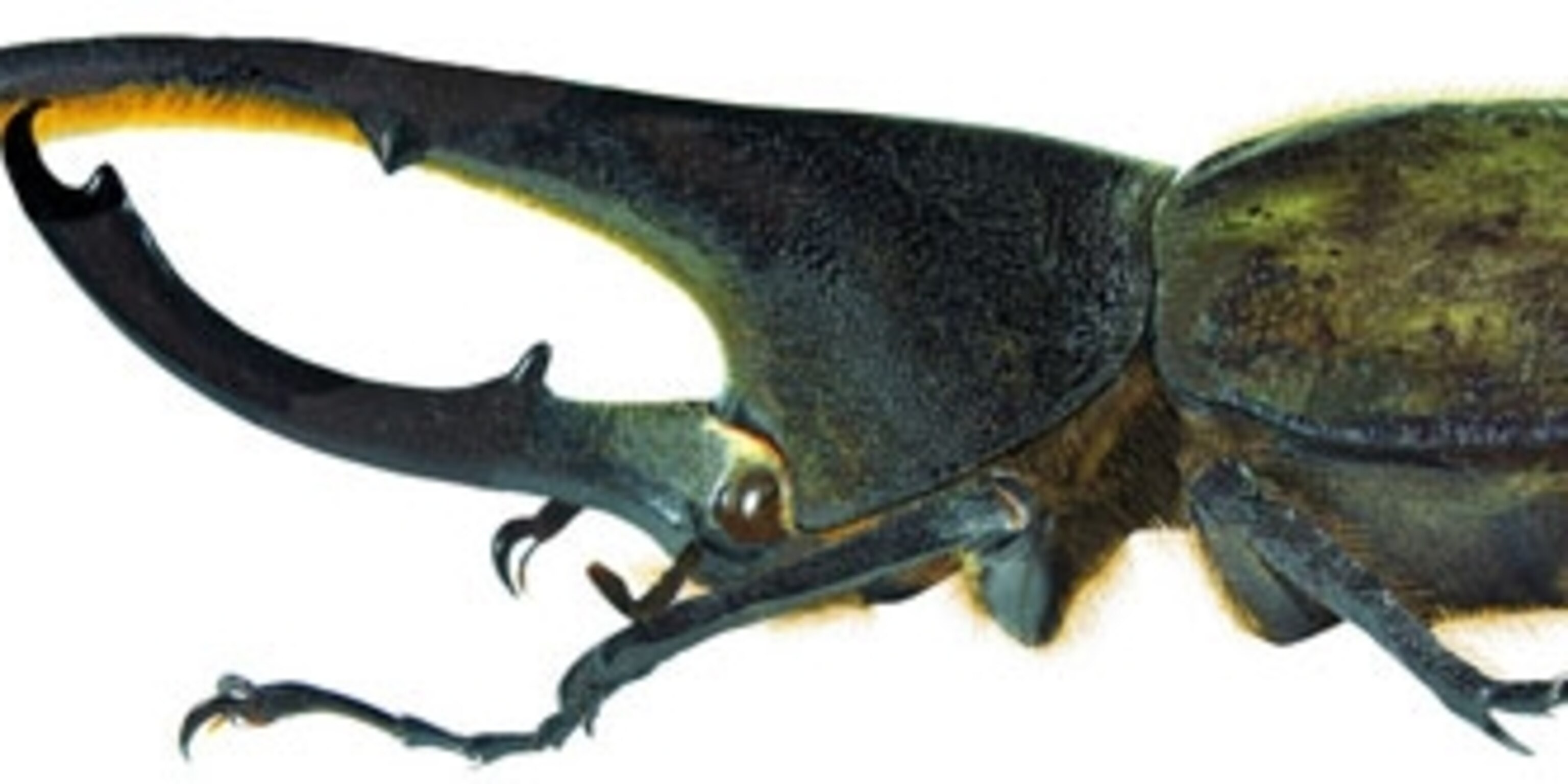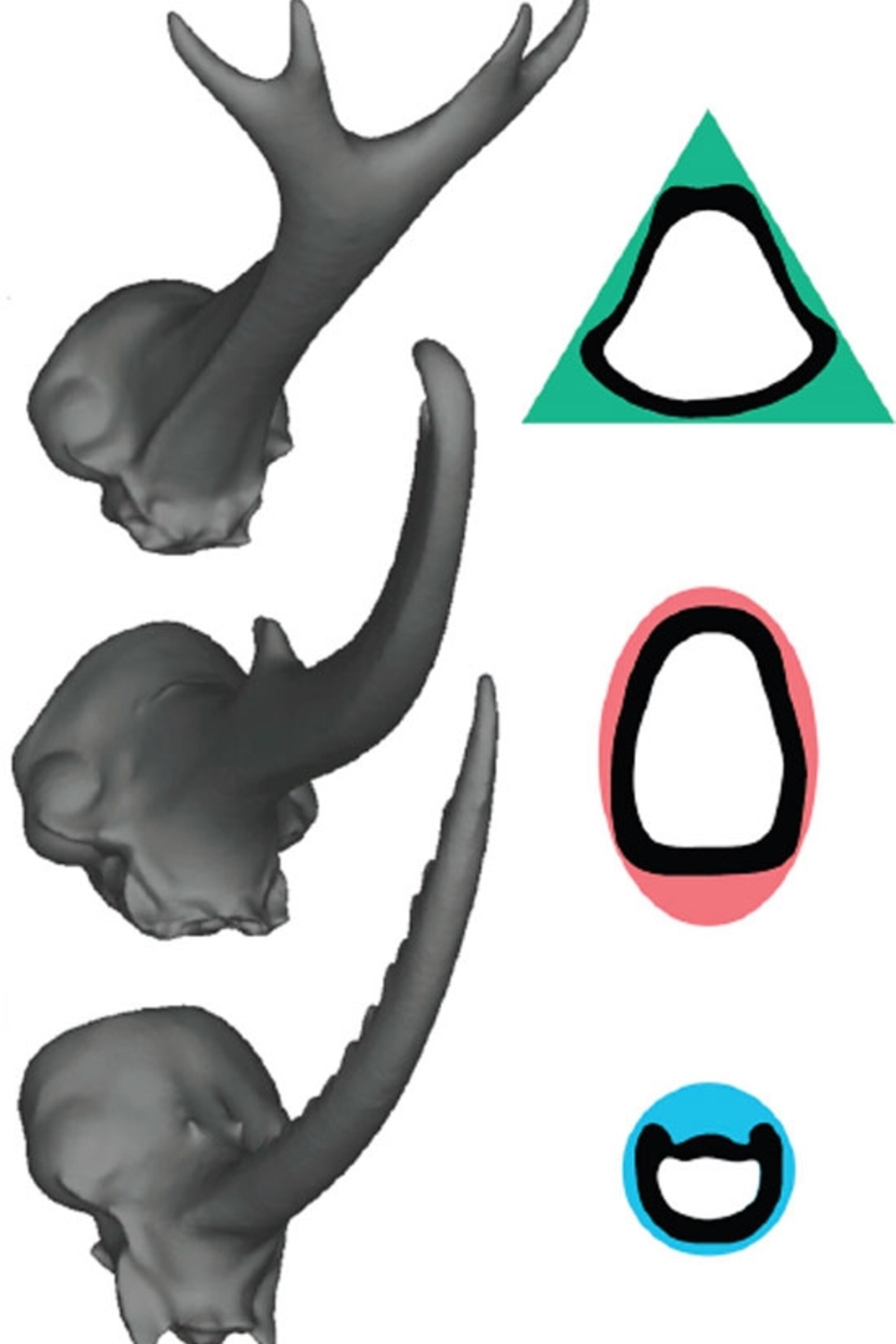
Rhino Beetle Weapons Match Their Fighting Styles
When longswords first came into use in the 13th century, knights mainly used them to slash through an opponent’s chainmail. But once plate armour entered the battlefield, these slashes were useless. Now, sword-wielders had to thrust their weapons into gaps and weak points—a new kind of fighting that required a different kind of blade. Longswords evolved to be longer, narrower, and more pointed. The central groove (the fuller) that lightened and strengthened the old models was replaced by a ridge (the riser) that conferred rigidity. A cutting weapon became more of a stabbing one. Form followed function.
Erin McCullough from the University of Montana found a similar trend among smaller but no less impressively armed combatants—rhinoceros beetles. As their name suggests, the males of these large, powerful insects have elaborate horns on their heads. In many animals, females choose males on the size and shape of their ornate structures. But that’s not the case for the rhino beetles. Their horns are purely weapons. They’re for grabbing, throwing and shoving rival males off branches and tree trunks, in a bid to control access to females.

Each species of rhino beetle has its own distinctive headgear, and each fights in a different style. The largest of them, the Hercules beetle (Dynastes hercules) has a huge horn curving down from its back and another curving up from its head. It looks like a disembodied pincer, and behaves like one too—males grab their opponents in a full-body hold, prise them off their perch, and toss them to the ground. (It can lift 850 times its own weight and, until recently, held the title of world’s strongest animal .)
The calliper beetle (Golofa porteri) has a much narrower horn with a serrated edge, which it uses to lift and shove its opponent—more of a fencer to the Hercules beetle’s wrestler. And the Japanese rhino beetle (Trypoxylus dichotomus), much beloved of cartoons and anime, has an upwardly curving horn that ends in a pitchfork. During fights, it tries to slide this tip under its opponent, to lift and twist it off its branch.

McCullough has found that the shape and structure of these horns are beautifully adapted to each beetle’s individual fighting style. Each one resists the types of forces that its owners typically experience, but threatens to snap or buckle when used in a different way. As with the longswords, form and function are linked.
This study wouldn’t have been possible through direct experiments. You can’t just pack a rhino beetle off to a new dojo, train it in a different martial art, and see how it performs. But McCullough did something similar, using a technique called finite element analysis (FEA). It’s a digital crash-test. You scan an object to create a three-dimensional virtual model, and then subject that model to forces of your choice. Engineers use it to simulate collisions between vehicles and obstacles. Biologists have used it to simulate collisions between jaws and prey. And McCullough used it to simulate collisions between beetles. In her computer, she could watch what happens if one rhino beetle fought its rivals in the style of another.
And what happens is: the horns do badly. For example, if you apply twisting forces to a Japanese rhino beetle’s horn, it holds up well. The virtual models are coloured in cool blues and greens, indicating low levels of mechanical stress. But if you twist the horns of the other two beetles, they light up in fierce reds and whites. In real life, they’d probably snap. In all three cases, McCullough found that the horns were least likely to snap or bend, when used in the directions that the beetles actually use them.

Some studies have shown that horned mammals also fight in ways that suit their headgear. Curved-horn sheep ram each other, short-horned gazelles stab, and long-horned oryxes wrestle. But none of these studies checked if the horns actually work best in these conditions, and whether they’d suit other techniques equally well. McCullough did that with her virtual crash-tests. “It’s intuitive but this is the first real direct evidence of that hypothesis,” she says. “It shows the possibility of using this new tool—finite element analysis—for understanding weapon diversity.”
She also correctly predicted the cross-sectional shapes of the three beetles’ horns, based on their fights. The Hercules beetle mostly uses its horn to grab and lift, so its ideal cross-section is an oval that’s vertically wide and horizontally narrow. The calliper beetle’s horn is used in more versatile ways and needs to resist forces in most directions—it should have a circular cross-section. And since the Japanese rhino beetle’s horn often twists, it would benefit from a U-shaped or a triangular cross-section resists bending and twisting. And that’s pretty much what the three horns are actually like. Based on function, you can predict form.
McCullough says that the results show how “male–male competition can drive the diversification of animal weapons”. But I wondered if the beetles could instead be fighting in a way that makes best use of their horns? A human fighter wouldn’t try to pummel someone with a dagger or to stab someone with a mace. Maybe function follows form?
“I get asked that a lot,” she says. She thinks that behaviour is probably more flexible than horn structure, so it’s more likely that the former changed to fit the latter than the other way round. But the only way to be sure is to test a wider range of beetles and to see how both their weapons and their combat techniques changed as the group diversified. Her group, led by Doug Emlen, is now working on that.
For more on the rhino beetles and other weapons, you may want to check out Doug Emlen’s upcoming book Animal Weapons: The Evolution of Battle.
Reference: McCullough, Tobalske & Emlen. 2014. Structural adaptations to diverse fighting styles in sexually selected weapons. PNAS http://dx.doi.org/10.1073/pnas.1409585111
Related Topics
Go Further
Animals
- Octopuses have a lot of secrets. Can you guess 8 of them?
- Animals
- Feature
Octopuses have a lot of secrets. Can you guess 8 of them? - This biologist and her rescue dog help protect bears in the AndesThis biologist and her rescue dog help protect bears in the Andes
- An octopus invited this writer into her tank—and her secret worldAn octopus invited this writer into her tank—and her secret world
- Peace-loving bonobos are more aggressive than we thoughtPeace-loving bonobos are more aggressive than we thought
Environment
- This ancient society tried to stop El Niño—with child sacrificeThis ancient society tried to stop El Niño—with child sacrifice
- U.S. plans to clean its drinking water. What does that mean?U.S. plans to clean its drinking water. What does that mean?
- Food systems: supporting the triangle of food security, Video Story
- Paid Content
Food systems: supporting the triangle of food security - Will we ever solve the mystery of the Mima mounds?Will we ever solve the mystery of the Mima mounds?
- Are synthetic diamonds really better for the planet?Are synthetic diamonds really better for the planet?
- This year's cherry blossom peak bloom was a warning signThis year's cherry blossom peak bloom was a warning sign
History & Culture
- Strange clues in a Maya temple reveal a fiery political dramaStrange clues in a Maya temple reveal a fiery political drama
- How technology is revealing secrets in these ancient scrollsHow technology is revealing secrets in these ancient scrolls
- Pilgrimages aren’t just spiritual anymore. They’re a workout.Pilgrimages aren’t just spiritual anymore. They’re a workout.
- This ancient society tried to stop El Niño—with child sacrificeThis ancient society tried to stop El Niño—with child sacrifice
- This ancient cure was just revived in a lab. Does it work?This ancient cure was just revived in a lab. Does it work?
- See how ancient Indigenous artists left their markSee how ancient Indigenous artists left their mark
Science
- Jupiter’s volcanic moon Io has been erupting for billions of yearsJupiter’s volcanic moon Io has been erupting for billions of years
- This 80-foot-long sea monster was the killer whale of its timeThis 80-foot-long sea monster was the killer whale of its time
- Every 80 years, this star appears in the sky—and it’s almost timeEvery 80 years, this star appears in the sky—and it’s almost time
- How do you create your own ‘Blue Zone’? Here are 6 tipsHow do you create your own ‘Blue Zone’? Here are 6 tips
- Why outdoor adventure is important for women as they ageWhy outdoor adventure is important for women as they age
Travel
- This royal city lies in the shadow of Kuala LumpurThis royal city lies in the shadow of Kuala Lumpur
- This author tells the story of crypto-trading Mongolian nomadsThis author tells the story of crypto-trading Mongolian nomads
- Slow-roasted meats and fluffy dumplings in the Czech capitalSlow-roasted meats and fluffy dumplings in the Czech capital